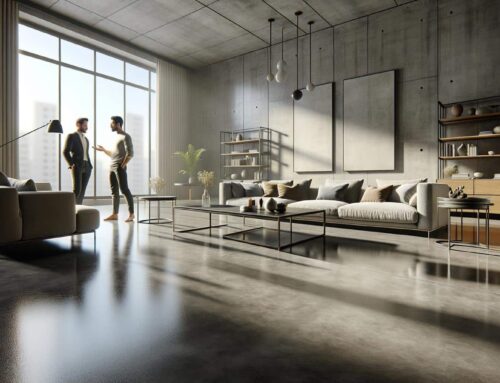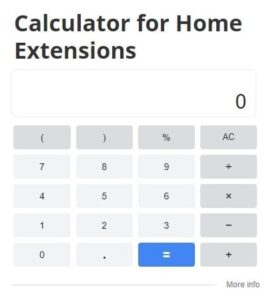
At Home Owners Association, we understand that choosing the right wood floor options can transform your living space. Wood flooring adds warmth, elegance, and value to any home.
With numerous types, styles, and installation methods available, selecting the perfect wood flooring can be overwhelming. This guide will help you navigate the world of wood flooring, considering factors like durability, cost, and environmental impact.
Main Types of Wood Flooring
At Home Owners Association, we understand that selecting the right wood flooring can transform your living space. Let’s explore the primary types you’ll encounter in the Australian market.
Solid Hardwood: Timeless Elegance
Solid hardwood flooring stands as a classic option many homeowners prefer. It consists of single wood pieces, typically 18-20mm thick. Oak, maple, and cherry rank among popular choices, known for their durability and aesthetic appeal. The National Wood Flooring Association states that wood floors can last over 100 years, making them a tremendous value.
This versatile flooring allows for multiple sandings and refinishings, enabling you to change its look over time.
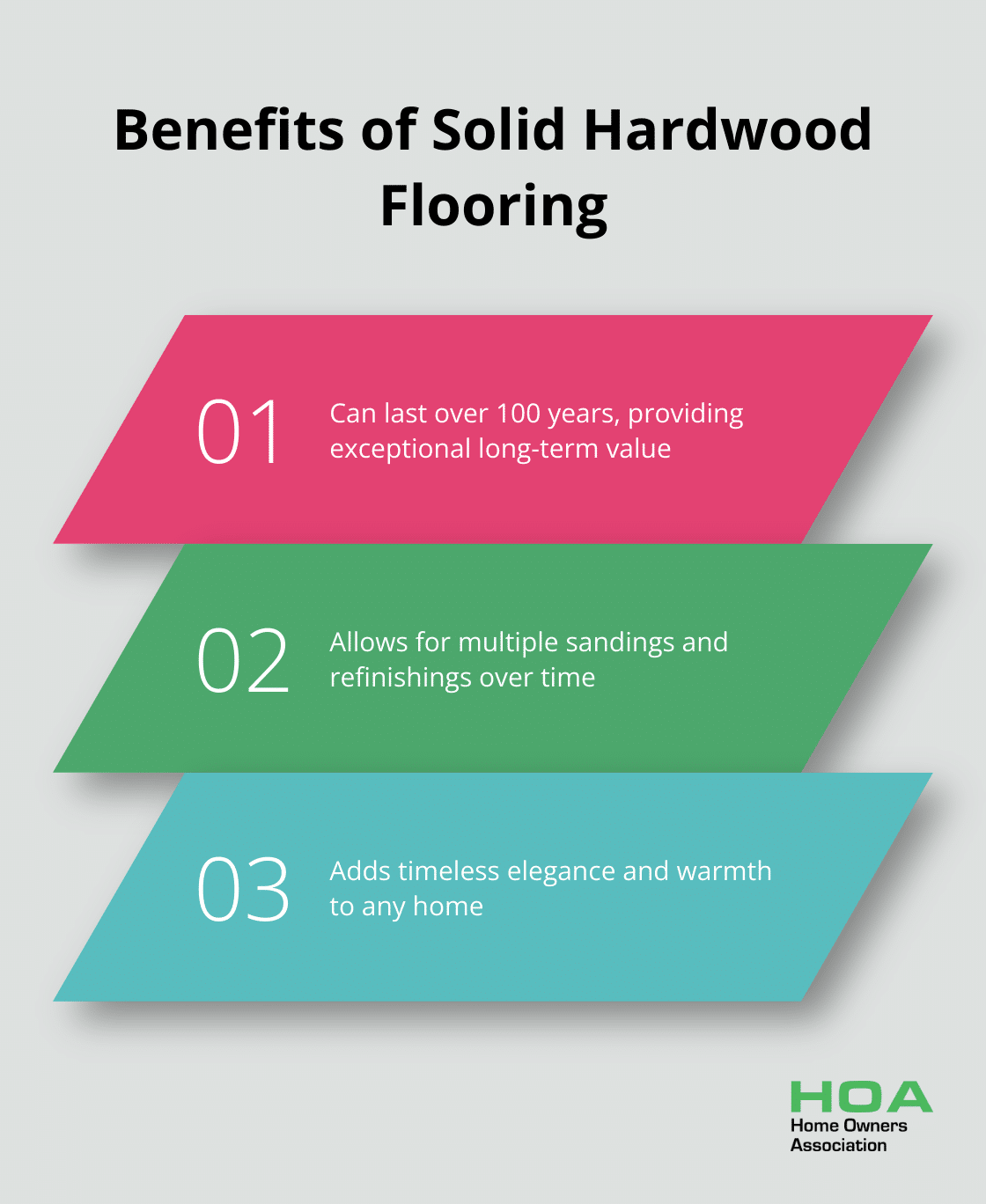
However, it reacts to moisture and temperature changes, which may cause warping or gaps between boards.
Engineered Wood: Stability Meets Style
Engineered wood flooring has surged in popularity due to its stability and versatility. It features a real wood veneer atop several plywood layers, reducing its susceptibility to warping in humid climates.
This flooring type excels in areas with higher moisture levels, such as basements or over concrete slabs. It also offers a more environmentally friendly option, using less hardwood per plank compared to solid wood alternatives.
Laminate: Affordable Durability
Laminate flooring provides a cost-effective alternative to real wood while replicating its appearance. Manufacturers create it from composite wood pressed together and topped with a photographic layer resembling wood grain. Laminate resists scratches, stains, and fading, making it ideal for high-traffic areas or homes with pets.
With a 15-25 year lifespan and simple DIY installation methods, laminate appeals to many Australian homeowners. It requires minimal maintenance, needing only regular sweeping and occasional damp mopping.
Eco-Friendly Options: Bamboo and Cork
For environmentally conscious homeowners, bamboo and cork flooring offer sustainable alternatives. Bamboo, technically a grass, grows rapidly and allows harvesting every 5-7 years, making it a renewable resource. It matches many traditional hardwoods in hardness and offers a unique aesthetic.
Cork flooring, harvested from cork oak tree bark, provides another eco-friendly choice. It boasts natural antimicrobial properties and offers excellent insulation and sound absorption. Both bamboo and cork prove durable, lasting 20-30 years with proper care.
When choosing wood flooring, factor in your home’s climate, room purpose, and long-term maintenance preferences. We recommend requesting samples and consulting with flooring experts to make an informed decision that aligns with your specific needs and style preferences. Now, let’s move on to the crucial factors you should consider when selecting your ideal wood flooring option.
Factors to Consider When Choosing Wood Flooring
At Home Owners Association, we understand that selecting the right wood flooring involves more than just aesthetics. Various factors can significantly impact a homeowner’s satisfaction with their flooring choice. Let’s explore the key considerations that should guide your decision.
Durability and Hardness: The Foundation of Long-lasting Floors
The Janka hardness scale serves as an essential tool for comparing wood species’ durability. As hardness is directly correlated with durability, wood floors that have higher Janka rating offer better resistance to normal wear and tear. For high-traffic areas or homes with pets, harder woods like oak or hickory prove to be wise choices.
Engineered wood flooring can offer increased stability in fluctuating humidity conditions. Some high-quality engineered options allow for 3-5 refinishes, which extends their lifespan significantly. This makes them a practical choice for areas with moderate moisture exposure.
Cost Considerations: Balancing Quality and Budget
Wood flooring prices in Australia vary widely. Solid hardwood typically costs between $60 to $120 per square meter, while laminate options start at $25 per square meter. Installation adds another $30 to $50 per square meter to your budget.
It’s important to factor in long-term value. While hardwood has a higher upfront cost, its longevity often makes it more cost-effective over time. High-quality hardwood floors can last over a century with proper care (according to the Australian Timber Flooring Association).
Maintenance: Keeping Your Floors Beautiful
Different wood flooring types require varying levels of maintenance. Solid hardwood may need refinishing every 7-10 years, depending on wear. Engineered wood and laminate options generally require less upkeep, often needing only regular sweeping and occasional damp mopping.
For busy households, low-maintenance options like luxury vinyl planks (LVP) can be ideal. These can last over 25 years and resist scratches and moisture, making them suitable for kitchens and bathrooms.
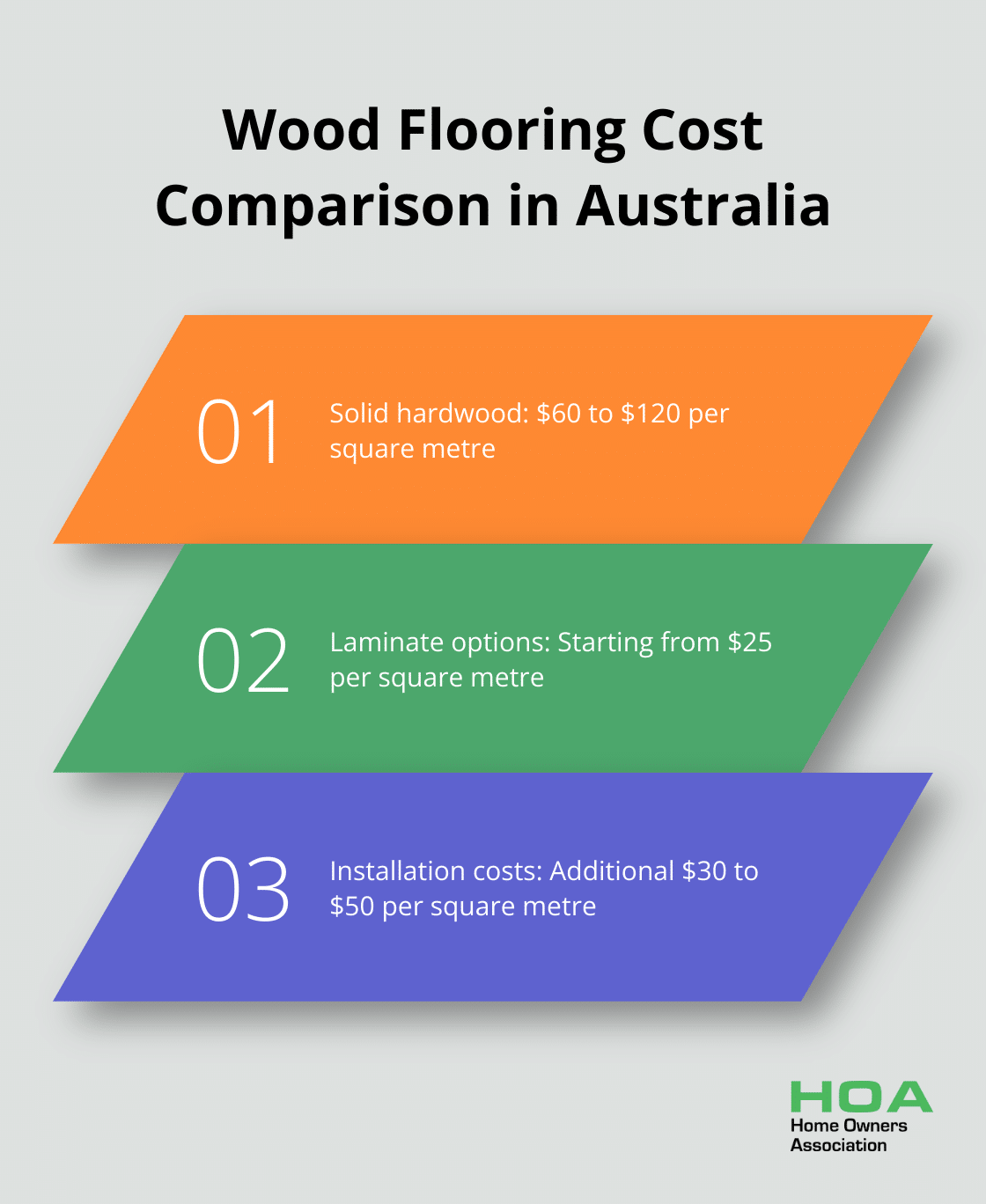
Environmental Impact: Making Sustainable Choices
Eco-conscious homeowners should look for certifications like FSC (Forest Stewardship Council) when choosing wood flooring. Every FSC label stands for sustainable sourcing that puts forests and people first. Bamboo and cork (rapidly renewable resources) offer sustainable alternatives to traditional hardwoods.
Engineered wood flooring uses less solid wood per plank, potentially reducing environmental impact. Some manufacturers now offer reclaimed wood options, which give new life to old materials and add unique character to your home.
Room Location and Moisture Levels: The Right Wood for Every Space
The location of your flooring within your home plays a crucial role in material selection. Basements and areas prone to moisture fluctuations benefit from engineered wood or luxury vinyl planks, which remain more stable in these conditions.
For sun-exposed areas, woods with natural UV resistance like teak or pre-finished options with UV-protective coatings can prevent fading. In kitchens and entryways, harder woods or moisture-resistant options like LVP can better withstand spills and heavy foot traffic.
Now that we’ve covered the key factors to consider when choosing wood flooring, let’s explore the various installation methods and their associated costs in the next section.
How to Install Wood Flooring
Professional vs. DIY Installation
The choice between professional and DIY installation depends on your skills, time, and budget. Professional installation costs $40 to $80 per square meter in Australia (on top of material costs). This price often includes subfloor preparation, which is essential for a durable installation.
DIY installation can reduce expenses but requires specialized tools and expertise. For engineered wood or laminate flooring with click-lock systems, DIY is more feasible. However, solid hardwood installation often benefits from professional expertise due to its complexity.
Installation Methods
Nail-down Installation
This traditional method for solid hardwood floors involves nailing planks directly to a wooden subfloor. It provides a solid feel underfoot but requires skill and specialized tools (such as a pneumatic nailer).
Glue-down Installation
Suitable for engineered wood and some solid hardwoods, this method works well over concrete subfloors. The process involves spreading adhesive and laying planks directly onto it. While it provides excellent stability, it can be messy and time-consuming.
Click-lock Floating Floors
Common with engineered wood and laminate, these floors don’t attach directly to the subfloor. Instead, planks lock together and “float” above an underlayment. This method is easiest for DIY enthusiasts but may not feel as solid underfoot as nailed or glued installations. Click-lock floating floors use less wood, fewer materials, and require no adhesive or nails.
Cost Considerations
The total cost of wood flooring installation varies based on wood type, installation method, and labor choice. Here’s a breakdown of average costs in Australia:
- Hardwood timber flooring: $50 to $150 per square meter (materials only)
Additional costs include underlayment, trim, and removal of old flooring. These can add to your total cost.
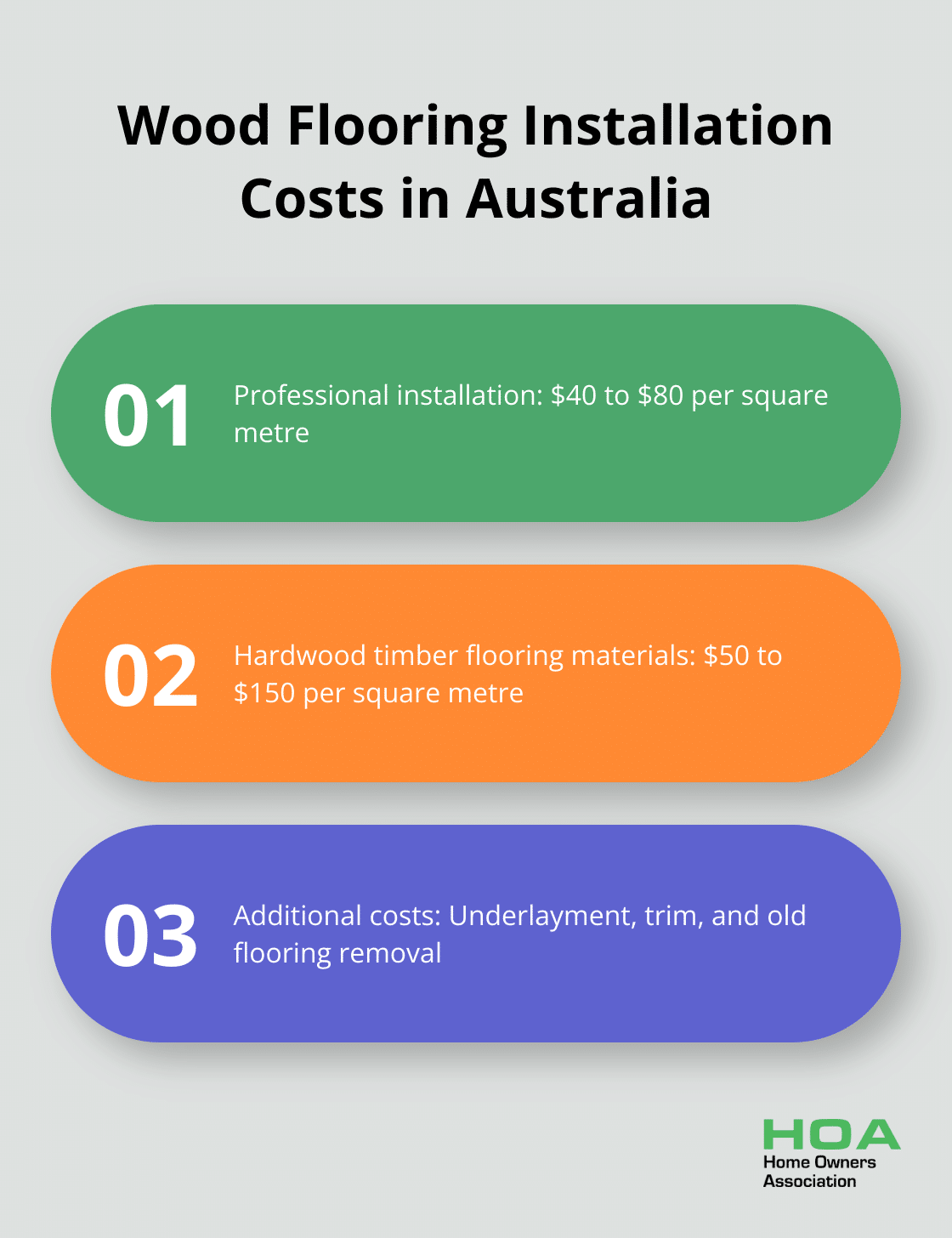
While DIY can save on labor costs, it often leads to higher material costs due to waste and potential mistakes. Professional installation, though more expensive upfront, can prove more cost-effective long-term due to better durability and fewer issues.
Proper installation is key to the longevity and beauty of your wood floors. Research thoroughly, prepare adequately, and consult with professionals if in doubt. The extra effort in ensuring a high-quality installation will pay off in the long run.
Final Thoughts
Wood floor options offer unique benefits, from the timeless elegance of solid hardwood to the stability of engineered wood. Durability, cost, maintenance, environmental impact, and room suitability all influence the decision-making process. Installation methods (professional or DIY) affect the overall cost and longevity of your flooring.
Your lifestyle and preferences should guide your choice of wood flooring. A busy household might prioritize durability and easy maintenance, while eco-conscious homeowners might prefer sustainable options. Consider your long-term plans, budget, and the specific requirements of each room in your home.
We at Home Owners Association can provide expert advice tailored to your unique situation. Our team of professionals offers personalized guidance to ensure you make the best choice for your Melbourne home. With our experience and resources, we can help you navigate the complexities of choosing and installing wood flooring, enhancing both the beauty and value of your home.

